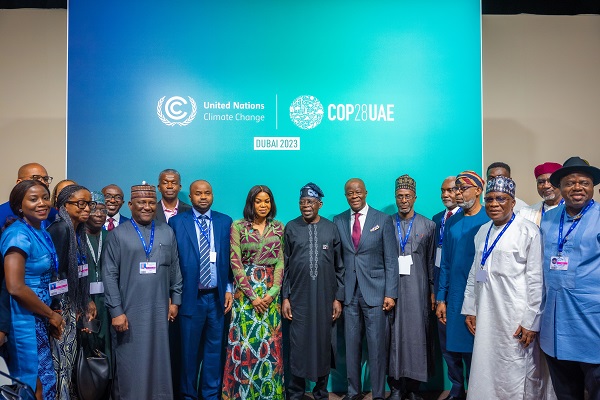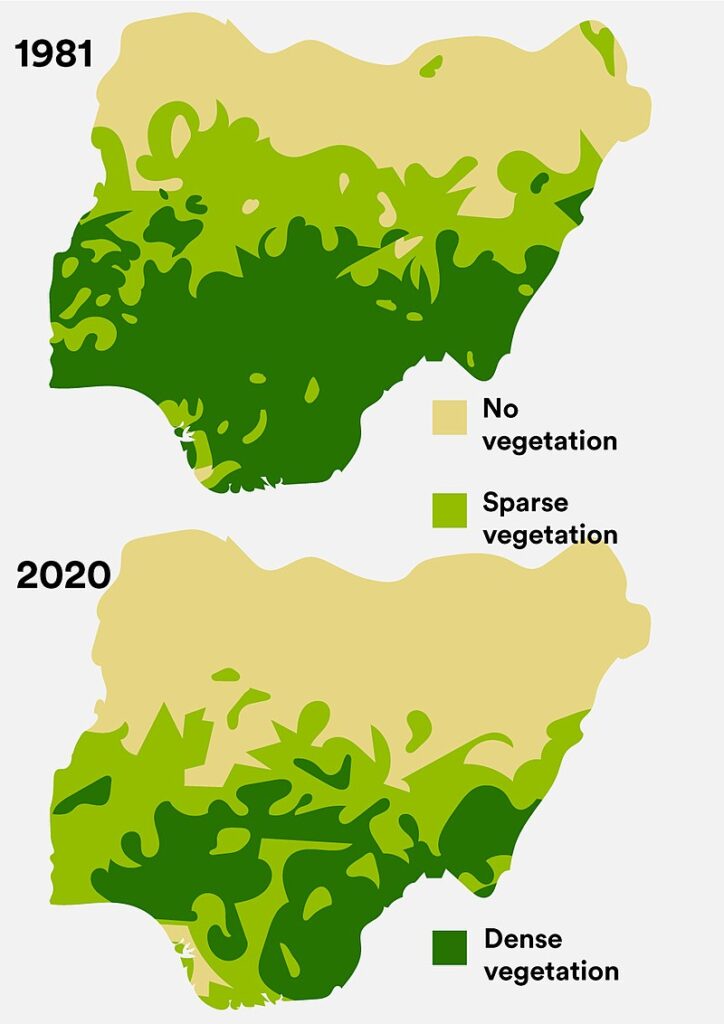6 February 2024
The “Giant of Africa”, Nigeria is a country rich with natural resources, and the largest population on the continent with 219 million people. Africa’s giant is predicted to get even bigger, as the population is forecast to grow to 377 million people by 2050. However, its natural resources are already under strain, with rising carbon emissions and increasing deforestation.
As part of our series of blogs looking at Nigeria in preparation for our Population Conversation roundtable event next week, we ask: with a booming population, what lies ahead for Nigeria’s environment?
Demographics
Nigeria has the biggest population and economy in Africa, with a population of 219 million. It’s predicted to overtake the US to become the world’s third most populated country by 2051. Nigeria’s rapid growth is the result of its large young population coming into child-bearing age, with currently half of the population under the age of 19. It’s home to some of Africa’s richest individuals, however stark wealth inequality divides the country, with two-thirds of the population below the poverty line.

Climate Change Vulnerability
Nigeria is a country incredibly susceptible to the effects of climate change. The capital city Lagos bordering on Nigeria’s coastline is vulnerable to rising sea levels. A UN report revealing that many communities in the Niger Delta have lost or fear losing their homes due to coastal erosion.
Rising global temperatures will also endanger Nigerians with an increasing frequency of heat waves. Nigeria’s Climate Risk profile predicts that more than 20% of the population will be exposed to heatwaves that are detrimental to human health. And the number of “very hot days” is set to increase by about 90 days in most regions.
Fossil Fuels
Nigeria’s economy is predominantly built upon oil and gas exports, profits from fossil fuels accounting for 93% of Nigeria’s export revenue. Nigeria produced 129 metric tons of CO2 in 2023, the 4th highest emissions in Africa.
The bulk of Nigeria’s emissions are from oil and gas production, and the practice of “gas venting”, where unwanted gases surfaced during oil production – predominantly methane – are released into the atmosphere. Methane is a greenhouse gas 28 times more potent that carbon dioxide.
There is also “gas flaring”, the practice of burning off surfaced gases, releasing carbon dioxide as a by-product that contributes to emissions. An estimated 6.6 billion cubic metres of gas was flared in Nigeria in 2021 – making it the world’s seventh largest gas flarer.

Despite the massive production of oil and gas, Nigeria has one of the highest rates of energy poverty in the world. The World Economic Forum defines energy poverty as the ‘lack of access to modern energy services and products’, a situation where there is an absence of sufficient choice in accessing adequate, reliable, affordable, safe, and environmentally suitable energy services.
86 million people lack access to electricity in Nigeria, with widespread power cuts affecting most of the population. Energy poverty is concentrated largely in rural areas, with communities instead relying on fuels such as kerosene, contributing to dangerous levels of indoor air pollution.
Firewood is also sourced as a fuel – contributing to Nigeria’s rapid deforestation.
Climate Pledges
Nigeria is signed up to the Paris Agreement, the international pledge made by countries to reduce their carbon emissions.
In its first climate policy submitted under the Paris Agreement in 2017, Nigeria pledged to reduce its greenhouse gas emissions by 20% below business-as-usual (BAU) levels by 2030.
In 2021, Nigeria passed the Climate Change Act, and recommitted to reducing its emissions by 20% BAU levels by 2030, rising to a possible 47% reduction on the condition of international support.
Climate Action Tracker rates Nigeria’s 2030 unconditional target as “1.5C compatible”, under the terms of the Paris Agreement.
In 2022, Nigeria announced its Energy Transition Plan, its plan to reach net-zero emissions by 2060. Under the plan, Nigeria has set targets to eliminate gas flaring by 2030.

However, several independent research groups have been critical of the plan’s reliance on natural gas expansion, declared the “decade of gas” by the government. The ETP aims to use gas as a “transition fuel” with a huge increase in gas consumption for national power in household and industry sectors by 2030, before phasing out gas by 2050 in favour of renewable energy sources. However, this plan risks locking Nigeria into carbon-intensive infrastructure, with industries designed around and reliant upon gas power.
Nigeria’s rapidly growing population will drive a huge demand for energy, putting an even greater strain on the later transition to renewable energies – wind and solar.

Deforestation
Nigeria naturally has a large expanse of forests, with swamp and tropical forests in the southern parts of the country, and a wooded savannah in the middle belt. However, Nigeria’s forests are rapidly disappearing, with the highest rate of deforestation in the world, losing 3.7% of its forest cover every year.

The World Economic Forum identified poverty as a driving force of deforestation in Nigeria.
Rural, low-income communities, depend upon forests for firewood, shelter, food, and economic prosperity. Forests are cleared for agriculture, with illegal cocoa farms expanding in protected rainforest reserves.
The margin of the poverty level is so high that anyone can sacrifice anything for food — including the forest.
Professor Babafemi Ogunjemite, 2020
Nigeria’s population explosion has not kept pace with job creation, the economy struggling to absorb the 5 million new entrants into the job market each year. The rapidly growing population only placing further strain on infrastructure and available resources. A lack of job opportunities in the urban centres has meant many graduates turn to other sources of income, resulting in the rise of illegal cocoa farms.
Commercial logging, both legal and illegal, is also a major cause of deforestation. Weak law enforcement and corruption has created an ongoing crisis of illegal logging in Nigeria.
The country is also experiencing rapid urbanisation, the urban population expected to double in the next two decades. Urbanisation driving deforestation as more and more people adopt city-based lifestyles, tending to use more resources, leading to forest clearing for urban space and to meet higher agricultural demand.

At COP26, the Nigerian government pledged to end deforestation by 2030.
Nigeria is also part of the Great Green Wall initiative to reverse deforestation, desertification, and environmental degradation across the African continent, partnered alongside 22 African countries.
The Great Green Wall aims to by 2030: restore 100 million hectares of degraded land, sequester 250 million tons of carbon, and create 10 million green jobs in rural areas. Currently, there has been little progress in planting the Great Green Wall – as of 2023, only 44 million acres of degraded land has been restored, amounting to 18% of the total target.
Conclusion
The Nigerian government has recognised the need to address climate change, but undermines its approach by continued rhetoric declaring the need for oil and gas expansion.
Nigeria’s rapidly growing population is the underlying driver of its rising energy demand, expanding agriculture, and increasing urbanisation – the results of which are causing environmental destruction.
To paraphrase a quote from our patron Sir David Attenborough, all of Nigeria’s environmental problems become easier to solve with fewer people, and harder, and ultimately impossible – to solve with ever more people.
The Population Conversation event due to be hosted by Population Matters in Abuja next week will provide an opportunity for Nigerian stakeholders to discuss all the challenges posed by its population growth and, most importantly, identify solutions that empower Nigerian people and help to protect and restore what remains of Nigeria’s rich natural landscape.
Source link : https://populationmatters.org/news/2024/02/population-and-the-environment-in-nigeria-too-big-to-go-green/
Author :
Publish date : 2024-02-06 08:00:00
Copyright for syndicated content belongs to the linked Source.





